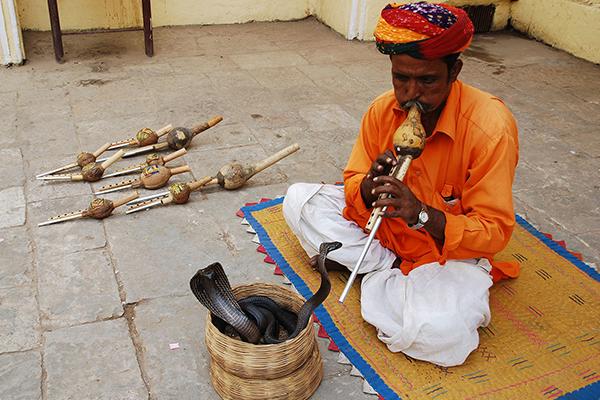Traditions - Snake Charmers

In India, snake charming has been illegal since 1970 but is still carried out in certain rural communities, also in Morocco and Tunisia it is still quite common to see snake charmers. In Morocco they are known as the Aissauas, a religious order with more than 500 years of history that captured snakes believing in their healing properties and exhibited them publicly in traditional markets and souks. Today, however, this activity is increasingly focused on profiting from tourists, so it is becoming more frequent to see the charmers around resorts, usually asking for money in exchange of pictures. This exploitation has caused a decline in the population of certain species. In 2014, there were at least 86 Aissauas in Morocco alone, 70 of them permanently in Marrakech.
Among the most used species are cobras and puff, horned or Maghreb snakes; all of them very poisonous species. Horseshoe whip snakes, bastard snakes, false cobras, Schoka’s bronzeback and viperines are also used. These animals are captured from their habitat or bought directly from hunters.
Living conditions
The snakes, captured from their natural habitat, live in small wooden boxes measuring about 15x40x60 cm. Inside, it is common for different species to be overcrowded, which sometimes leads to predation, cannibalism or poisoning.
Not all snakes receive the same attention: the more expensive species (cobras and puff adder) are given certain care, while those of lesser value are hardly paid attention and end up dying of dehydration and starvation after a few months.
Snakes barely manage to live a few months in these conditions and when they die their skin is removed and their flesh is used to feed the rest of the snakes.
The mystery of enchantment
The apparent hypnotic state of the snakes in these activities is due to the pain, dehydration and starvation in which they find themselves. The vision of the flute resemble a possible predator, therefore the snakes stand in a defensive attitude to keep fighting for their survival.
Once captured and in order to avoid being bitten, their fangs are cut off and their mouths are tied with small plastic strings that only allow them to stick out their tongues. It is common to see specimens with deformed mouths due to the mutilation of their fangs (especially in poisonous species) that is carried out from time to time as they regenerate their teeth. Their poison glands are also removed by inappropriate methods and unhygienic techniques. Snakes are barely able to eat and are in a state of starvation. These living conditions cause most of them to die from hunger or infections as a result of mutilation.
It is essential that as a responsible traveler you never pay for the photo or "show" of a snake charmer. The longer tourism continues to finance these activities, the more difficult it will be to properly regulate these traditions in their home country.
